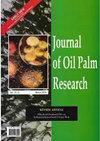用改进的中试连续炭化系统从油棕果壳中获得高产优质炭
IF 1.3
4区 农林科学
Q2 Agricultural and Biological Sciences
引用次数: 0
摘要
本研究通过改进的中试规模连续碳化系统,即中试回转窑(PRK),与间歇式传统碳化方法,即Taki碳化系统(TCS),比较了油棕榈仁壳(OPKS)生产的木炭的产量、质量和产量。先前的调查表明,PRK的高能效为55%,而TCS为38%。此外,PRK的OPKS-charcoal产率为30±2.4%,高于TCS的22±1.7%。改进后的系统是一个自我维持的碳化过程,可以连续运行8小时,而TCS需要72小时才能将相同数量的OPKS转化为木炭。通过PRK还获得了质量良好的木炭(固定碳83.7±2.0%,挥发物10.2±1.4%,灰分6.1±1.2%,热值33.1±1.8 MJ kg−1)。本研究还表明,PRK方法在财务上比TCS更可行,因为它预计需要更低的资本成本和更高的效益成本比(B:C),棕榈油加工厂经营者可以实现。本文章由计算机程序翻译,如有差异,请以英文原文为准。
HIGH YIELD AND QUALITY CHARCOAL FROM OIL PALM KERNEL SHELL WITH AN IMPROVED PILOT-SCALE CONTINUOUS CARBONISATION SYSTEM
The present study compared the production, quality, and yield of charcoal manufactured from oil palm kernel shell (OPKS) via an improved pilot-scale continuous carbonisation system, the pilot rotary kiln (PRK), with a batch conventional carbonisation approach, the Taki carbonisation system (TCS). Previous investigations demonstrated that the PRK was highly energy-efficient at 55% compared to 38% in TCS. Furthermore, the PRK attained a higher OPKS-charcoal yield at 30 ± 2.4% than TCS, which produced 22 ± 1.7%. The improved system was a self-sustaining carbonisation process that could continuously run for eight hours, whereas the TCS required 72 hours to convert the same amount of OPKS into charcoal. A good quality charcoal (83.7 ± 2.0% fixed carbon, 10.2 ± 1.4% volatile matter, 6.1 ± 1.2% ash, and 33.1 ± 1.8 MJ kg −1 higher heating value) was also acquired via the PRK. The present study also demonstrated that the PRK approach was more financially feasible than TCS as it was projected to require lower capital cost and a higher benefit-to-cost ratio (B:C), which palm oil mill operators could achieve.
求助全文
通过发布文献求助,成功后即可免费获取论文全文。
去求助
来源期刊

Journal of Oil Palm Research
农林科学-食品科技
CiteScore
2.60
自引率
30.80%
发文量
69
审稿时长
>12 weeks
期刊介绍:
JOURNAL OF OIL PALM RESEARCH, an international refereed journal, carries full-length original research papers and scientific review papers on various aspects of oil palm and palm oil and other palms. It also publishes short communications, letters to editor and reviews of relevant books. JOURNAL OF OIL PALM RESEARCH is published four times per year, i.e. March, June, September and December.
 求助内容:
求助内容: 应助结果提醒方式:
应助结果提醒方式:


